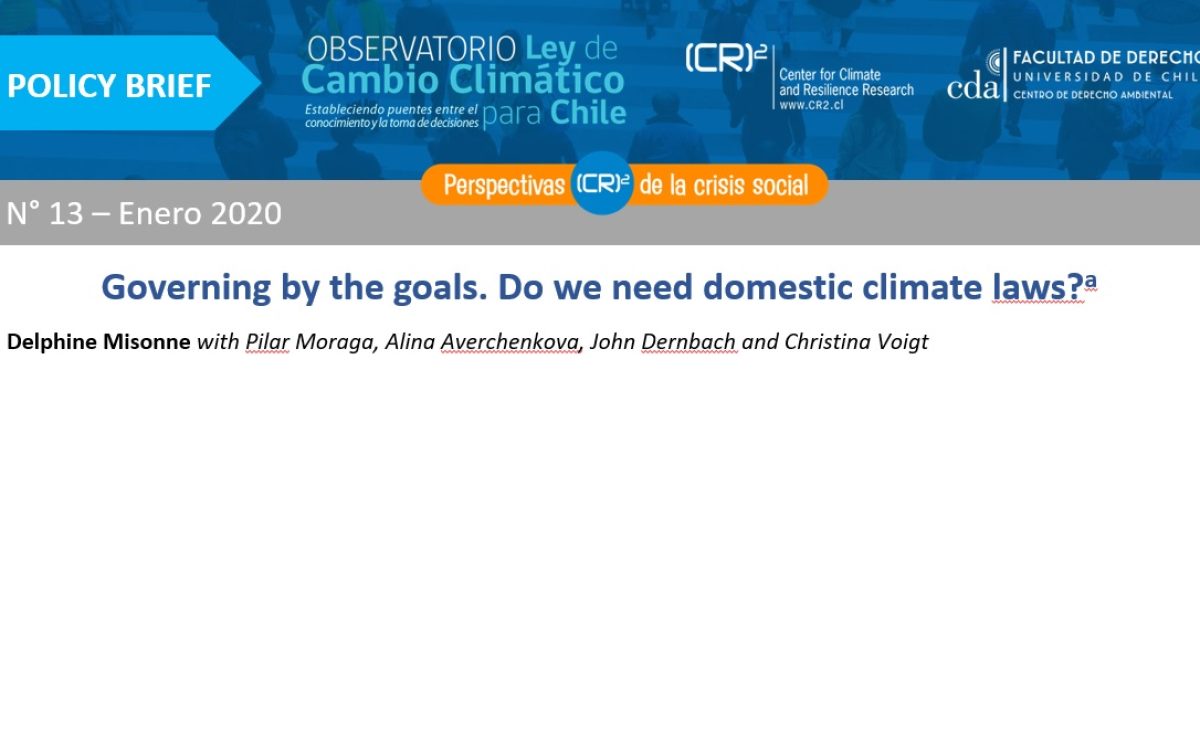Conferencia presentada en side event del mismo nombre, en la COP 25. Madrid, 11 de diciembre de 2019. Benelux-EIB Pavillon
Delphine Misonne with Pilar Moraga, Alina Averchenkova, John Dernbach and Christina Voigt
Side Event ‘Governing by the Goals. Do we need domestic climate laws’, COP 25, Benelux-EIB Pavillon, Madrid, December 11, 2019.
At the occasion of COP25, a debate on climate laws in the world, across continents, took place in Madrid, at the Benelux-EIB Pavillon, on December 11, 2019.
The debate was organized at the initiative of Prof. Delphine Misonne[1], Université Saint-Louis Bruxelles, CEDRE, who acted as a moderator, and included panelists Dr. Alina Averchenkova, London School of Economics, Grantham Research Institute on Climate Change and the Environment; Prof. John Dernbach, Widener University Commonwealth Law School; Prof. Pilar Moraga, Universidad De Chili, Observatorio Ley del Cambio Climatico para Chile; Prof. Christina Voigt, Oslo University, Chair of the Climate Change Specialist Group of the IUCN World Commission on Environmental Law.
The present policy brief fixes the salient elements which popped up in the discussion and highlights the main conclusions, as further food for thought
- CONTEXT
The most decisive part of the Paris agreement lays in the collective goals that were agreed upon in 2015: the goal of temperature, the goal of adaptation, the goal of reorientation of financial flows, the goal of carbon neutrality. Most of the international governance is today articulated around those collective goals, the settlement of which was a crucial step forward. That trend to govern by the goals is also noticeable at regional level, like in the European Union, where collective targets, not always individualized, now guide the action expected from Member States with regard to the energy transition.
If these goals are sufficient and how to reach them are topical questions. Discussions were still pending at COP25 on the modalities of potentially worldwide carbon markets and on the resurgence, somehow, of other previous flexible mechanisms – and will pursue in 2020 as no agreement could be reached on the issue in Madrid-. For the rest, for the bulk part, on the type of concrete efforts to be made to reach these goals, it is now up to each individual Party to decide.
This is another aspect of the deal concluded in Paris in 2015: concrete contributions to the collective goals, whatever the form they may take, shall be decided at Party level.
This translates, in the very framework of the Paris agreement, in a call to make plans and pledges: the need to prepare, communicate and maintain nationally determined contributions, the legal nature of which is not specified and open to interpretation.
In such context of governance by the goals, do Parties need to adopt domestic climate laws?
The question might sound odd. The answer depends upon the current legal acquis but also, more fundamentally, upon the specificities of the country’s constitutional approach, on the type of state structure, and even more importantly perhaps, upon the political acceptance of that very word, legislation.
A law, in and by itself, will never be sufficient to implement Paris. It can only be a piece in a larger puzzle and in network of interactions. Yet, it is worth recalling that the lawmaker is not just any actor. And that a law is necessarily different, in its potential of achievement and in its procedural preconditions, from a mere programmatic instrument, like a plan or a pledge.
Questioning the need for laws to be adopted or consolidated or changed at domestic level in relation to the climate challenge, means questioning the need to engage with the fundamentals of our democracies. Parliaments represent the people. Negotiations in Parliaments are observed, scrutinized. Parliaments have the power to create obligations but also to affirm new rights, in due respect of constitutional provisions. They also have the power to undo preexisting legislation.
- DEBATE
The purpose of the panel session was to share thoughts around three main questions, taking stock of recent advances in legal and political academic research:
- Do we need domestic climate laws on top of existing common goals, in order to achieve the necessary transition?
- What were the tricky elements in bringing laws into the discussion on how to fulfill the collective goals?
- There is a UK Climate change Act that already plays an influence across the world but is it still a “gold model”, in a post Paris-Agreement era?
- Do we need domestic climate laws, on top of existing common goals, in order to achieve the necessary transition?
Preconditions: a capacity
The discussion on climate laws cannot be detached from an assessment of the constitutional specificities of each country.
Pledges made on the international scene can prove difficult to meet due to institutional and constitutional reasons, which must not be underestimated and should be clarified.
In Chile, as explained by Pilar Moraga, the Orden Público Económico dramatically impacts the power of the state in organizing the conditions of its own economic development. Private property and freedom of enterprise benefit from strong constitutional guarantees. Too strong, as this is one of the reasons for the current social uproar and the displacement of COP25 in Madrid. The head of State, while prone to declare a moratorium on coal powerplants when discussing climate policies in international fora, does not actually detain any power to influence such lock-out of coal. New energy priorities impose to open bilateral negotiations, so-called voluntary agreements, with energy companies, not a trifle. And these agreements are also voluntary as far as compliance is concerned – recent agreements were not respected, arguing of the social crisis. Currently, the Chilean institutional framework is too weak to materialize measures that are indispensable for reaching climate neutrality. Only the lawmaker can actually change the tide, in due respect of the Constitution, or a new Constitution.
In Europe, the balance between the economic interests and other interests is assessed in the framework of the European Convention on Human Rights and related national Constitutions. State can enforce laws as they deem necessary to control the use of, say, property, in accordance with the general interest; by contrast, restricting the use of property without an appropriate legal base will prove rather risky and inappropriate. Limitations to rights for the sake of the general interest, like protecting the environment, can only be prescribed by law.
If a value is recognized and framed by the lawmaker, its protection gets necessarily stronger, and this is of importance in litigation processes. The European Court of Justice gave an opinion, earlier this year, on April 30[2], on the compatibility of the Comprehensive Economic and Trade Agreement concluded between the EU and Canada, better known under the acronym ‘CETA’, with the European Union constitutional framework. That opinion had been requested by Belgium as fears arose that such new Agreement could prove detrimental to the fulfillment of climate commitments. The main issue concerned the proposed mechanism for settling disputes between investors and states. The full Court was of the opinion that the proposed mechanism is compatible with EU primary law, because the new tribunal will not have jurisdiction to call into question “the choices democratically made within the European Union” relating to, inter alia, the protection of the environment. Law necessarily matters, in such context.
At last, it is relevant to discuss the need for new legislation, but one must not forget to assess the extend to which existing laws get in the way.
Climate Acts
A Climate change Act is actually currently pending before Congress in Chile, setting targets, besides other legislations on electricity, on renewables, on public tenders, which were decisive in promoting the transition.
Norway decided to become a low carbon society, a “low greenhouse gases emissions society” and this was made clear in a recent Climate Act[3], adopted in 2017 and applicable since 2018. It codifies targets, both for 2030 and 2050[4], and makes them legally binding. The purpose of the Act is to promote transparency and to install a public debate on the status, direction and progress of that societal project. But the most innovative advance is the budgetary post. In each annual budget, the government must foresee how Norway can achieve its climate targets and the expected effect of the proposed budget on greenhouse gases emissions.
In the US, the current legal acquis is already potentially very helpful in achieving a goal of 80% of greenhouse gas emissions reductions by 2050. Legal tools exist, at all levels (federal, state, local, even private), as explained in a recent book, a “legal playbook”, Legal Pathways to Deep Decarbonization in the United States, edited by J. Dernbach & M. Gerrard, at the Environmental Law Institute, Washington[5].
With their team, they identified five pathways to deep decarbonization, which are energy efficiency and conservation, decarbonization of electricity, switching of end-use fuels to electricity, carbon capture and negative emissions, but also, even if less frequently said in climate circles, a significant reduction in non-carbon dioxide pollutants. The range of tools is very wide, already well known (additional regulation, market-leveraging approaches, tradable permits and allowances, reduction or removal of legal barriers, removal of incentive for fossil fuel use, information and persuasion, infrastructure development, etc.).
A quite different issue, however, is the question whether the lawmaker must fix the goals himself.
The UK climate act was quite innovative in that regard: the Act itself fixes the goals indeed, since 2008 already, and had an influence across the world, as explained by panelist Alina Averchenkova.
The State of New-York also recently endorsed that same approach, with its New York state climate leadership and community protection Act (CLCPA) of 18 July 2019. The law establishes mandatory targets[6] to reduce greenhouse gas emissions and sets a timeline. It creates a Climate Action Council and sets out procedures calling for a two-year consultation process[7]. The title of the Act itself is quite noticeable.
Laws themselves are building blocks, says panelist John Dernbach. They must be seen as elements of a sequence.
The current situation in the US illustrates the complexities but also subtleties of federalism. Capacities of political resilience are stemming out of multiple levels, including large cities or states, which also detain a legislative role at their own scale. Where the federal level blocks, other levels do still detain a margin of action.
In Belgium, a recent proposal for a nation-wide climate Act, based on a spontaneous academic proposal[8] the aim of which was to ease governance and impose coordinated targets, was recently discussed in Parliament, including a need to change the Constitution, but was rejected, in 2019. That proposal had been made to meet the demands of the Paris Agreement and of European Union legislation, especially the 2018 Regulation on the Governance of the Energy Union, which impose to Member States new dynamics in integrated planning, in order to decarbonize their economy. The challenge is very demanding in a country where competences are distributed according to a principle of exclusivity and questions the adequacy of current structures to provide a swift and coordinated answer.
Currently, in Belgium, climate acts actually already exist at regional level, like the Walloon decree of 2014, inspired by the UK Act. That Decree was recently modified, in May 2019, in order to impose a “climate test”, which still needs to be implemented. It entails that all governmental decisions shall need to be assessed based on their incidence on greenhouse gases emissions[9].
Added value
Climate laws are necessary because they are the only way to make the nationally determined contribution binding.
Their main impact is to de facto put a price on carbon, says Christina Voigt. “If we care about the Paris Agreement, we need domestic laws”, she says.
A climate law is not only about fixing goals, it is about creating infrastructure, according to Alina Averchenkova.
In the UK, one of the major elements of the Climate Change Act was the creation of an independent advisory body that provides advice on the level of efforts and monitors implementation on the law. The Act improves the quality of the political debate. It builds upon a recognized independent expertise and helps avoiding polarization.
It also ensures continuity and political commitment to climate change objectives, despite changes in governments.
A climate law ads value as it creates the power to mobilize society.
- What were the tricky elements in bringing laws into the discussion on how to fulfill the collective goals?
Trial and error
The lack of experience on such a radical challenge, the decarbonization at speed of an economy, is an impediment. The challenge to be dealt with is unprecedented.
The Paris Agreement was decisive in pushing Parties forward towards the adoption of new legislation. In Norway, the Paris Agreement acted as a trigger factor for revitalizing discussions on the need for a climate law. Norway has a climate law since June 2017, only because Paris happened.
It is not so easy to think at global level, and to consequently implement at local level. The articulation can prove to be difficult. It is very experimental and not fed by a demonstration, somewhere, that it might properly work. Climate laws are also quite recent. Countries proceed by trial and error.
Targets and pledges are proposed in the NDC’s, but how to achieve them depends not only on the availability of appropriate tools but also on the legal robustness of institutional capacities.
The lawmaker has a fundamental role in defining appropriate structure and instruments.
Building societal support ante- and post-
Such climate Acts must also benefit from a strong societal support. This means they need to be accompanied or preceded, at some stage, by an inclusive process and a positive narrative.
A strong ownership through stakeholder consultation is necessary and the best guarantee against legislative reversal. In the UK, the Climate Act is known as “one of the least opposed pieces of legislation, having passed with only 3 votes against”, said Alina Averchenkova. This was due to a strong cross-party consensus on the need to act on climate change and de-politicization of the law by focusing on the long-term target and the processes and timelines for defining the intermediate steps, while leaving some flexibility to determine specific policies to meet the targets.
Flexibilities on specific policies in such Acts are useful in helping achieve political consensus but they need to be backed by clear mandates and timelines to develop policies, strong parliamentary oversight and independent review, also explained the panelist.
A debate arose on the question whether climate Acts trigger litigation.
Litigation can also arise in the absence of a climate Act, as demonstrated by the Urgenda Case in the Netherlands. When the first judgement was made, in 2015, plaintiffs found in the Civil Code and in the European Court of Human Rights the arguments they needed to convince the judges; there was no specific Climate Act in the country at the time. The judgment has now become final, with the decision of the Supreme Court of 20 December 2019[10]. Climate change is an issue of fundamental rights. The Dutch State as a positive duty to protect its citizens, their life and well-being, against climate change and to further reduce greenhouse gases emissions.
It is also the absence of climate legislation which creates a frustration and leads to litigation, said Delphine Misonne, quoting Prof. Michael Gerrard.
- And, at last, we know that there is a UK Climate change Act that already plays an influence across the world but is it still a “ gold model “, in a post Paris-Agreement era?
No relevance of a gold model
There is no gold model, no template that would suit all countries, because countries have different traditions, legal and political contexts.
On public participation, for instance, the fact that such dimension is not dealt with in a Climate act does not mean it is not taken into consideration. It might be, but elsewhere in the legal system.
The approach will also be dependent of constitutional approaches, which can differ quite radically, for instance on economic issues, like in Chile.
If there is no gold template, key elements are recurrent, like long-term and mid-term targets, carbon budgets, stakeholder engagement or the creation of an independent advisory body with a clear mandate.
“The scope of a legislative instrument is one of the first critical decision that need to be taken when developing a new law”, as highlighted by Alina Averchenkova, from a comparison of the experience of seven countries, available in ‘Legislating for a law carbon and climate resilient transition: learning from international experiences’[11].
Fairness and equity
The social crisis that has unfolded in Chile in recent weeks shows that the energy transition and carbon neutrality target must be fair and cannot translate into a new source of social and environmental inequalities, as highlighted by Dr. Pilar Moraga. Both a country level and planet level.
In this respect it seems pertinent to ask oneself who needs to assume the burden of this transition? In Chile, aside from the emissions reduction target of Chile’s energy sector, there is a forestry objective. But the land available for plantations belong to small-scale landowners and indigenous or vulnerable communities that until now have not seen the quality of their life improved thanks to the development of the power industry. So far, they have seen their exposure compounded, for example, by forest fires, which are becoming increasingly frequent in the country.
An open question remains what measures lawmakers, as well as the international community, will adopt in order to prevent these communities from worsening their state of poverty.
III. ESSENTIALS OF THE DISCUSSION IN A NUTSHELL
- Climate laws play an essential role in enabling achievement of the goals
- Pledges will remain to no avail if domestic institutional frameworks are too weak to materialize them
- Climate transition challenges the domestic capacity to impose radical changes to economic actors
- Lawmaking is the only way to make targets legally binding
- A robust climate legislation de facto puts a price on carbon
- A climate law is about creating infrastructure
- A climate law means mobilizing society
- All panelists were most favorable to the idea and concept of climate law
- Building up political support needs a positive narrative
- The challenge is new. Countries proceed by trial and error
- Federalism and problems in leadership do not prevent other level of powers to take the lead
- There can’t be a one-size-fits all gold model, because countries have different legal traditions, which must be properly assessed
- A climate act must be fit in its own context, made of the constitutional essentials and type of devolution/federalism
- A key element in most laws is the independent advisory body
- An innovative dimension: the budgetary post – how to achieve climate targets must be dealt with in each annual budget, together with an assessment of the expected effect of the proposed budget on greenhouse gases emissions
- Fairness is of the essence. Climate laws must not become a new source of social and environmental inequalities and worsen poverty
And at COP25?
The session did not actually raise negative elements with regard to the very need to adopt climate acts. At COP25, there was like an atmosphere of ‘being in the mood’ for it. Parties with a climate law or draft climate law seemed eager to advertise it.
The European Union itself announced its intention to propose a “EU climate law” as part of its new green new deal, “that would not be prescriptive in the traditional way”, according to F. Timmermans.
It was also noticeable at COP25 that the issue of “law” at large, including litigation, is now central in many discourses on climate action.
Descargar policy brief en PDF AQUÍ
Notas
[1] With special thanks to the Belgian delegation for allowing academics to organize sessions in such premises and for including societal actors from the Belgian Federal Council for Sustainable Development, in a role of observer, in the delegation. This in due regard of art. 3.7 of the Aarhus Convention, according to which Parties shall promote the application of the principles of access to information and public participation in international environmental decision-making processes and within the framework of international organizations in matters relating to the environment.
[2] Opinion 1/17, ECLI:EU:C:2019:34.
[3] https://www.regjeringen.no/en/dokumenter/climate-change-act/id2593351/
[4] Section 4. « A low-emission society means one where greenhouse gas emissions, on the basis of the best available scientific knowledge, global emission trends and national circumstances, have been reduced in order to avert adverse impacts of global warming, as described in Article 2 1.(a) of the Paris Agreement of 12 December 2015.The target is to achieve reductions of greenhouse gas emissions of the order of 80–95 % from the level in the reference year 1990. The effect of Norway’s participation in the EU Emissions Trading System is to be taken into account in assessing progress towards this target.”
[5] https://www.eli.org/eli-press-books/legal-pathways-deep-decarbonization-united-states
[6] The Act requires the state to use 70 percent renewable energy by 2030 and 100 percent renewable energy by 2040. The legislation also requires the state to reduce greenhouse gas emissions by 40 percent based on 1990 levels by 2030 and 85 percent by 2050.
[7] https://www.columbiaspectator.com/news/2019/10/24/what-it-takes-to-implement-the-climate-protection-act-in-new-york/
[8] The chair of the session, D. Misonne, was one of the pilots in the academic group which proposed that academic project. The proposal was soon adopted by political parties and discussed in Parliament. It also led to discussions on the need to change the Belgian Constitution in order to ease climate governance.
Parliamentary works and minutes of the debate can be read at : doc. 54/3517 & doc. 54/3642 https://www.lachambre.be/kvvcr/showpage.cfm?section=flwb&language=fr&cfm=/site/wwwcfm/flwb/flwbn.cfm?dossierID=3642&legislat=54&inst=K; https://www.lachambre.be/kvvcr/showpage.cfm?section=flwb&language=fr&cfm=/site/wwwcfm/flwb/flwbn.cfm?dossierID=3517&legislat=54&inst=K
[9] http://environnement.wallonie.be/legis/air/air074.html
[10] https://www.urgenda.nl/en/themas/climate-case/
[11] A. Averchenkova, Legislating for a low carbon and climate resilient transition: learning from international experiences, Elcano Policy Paper, January 2019, available online.










